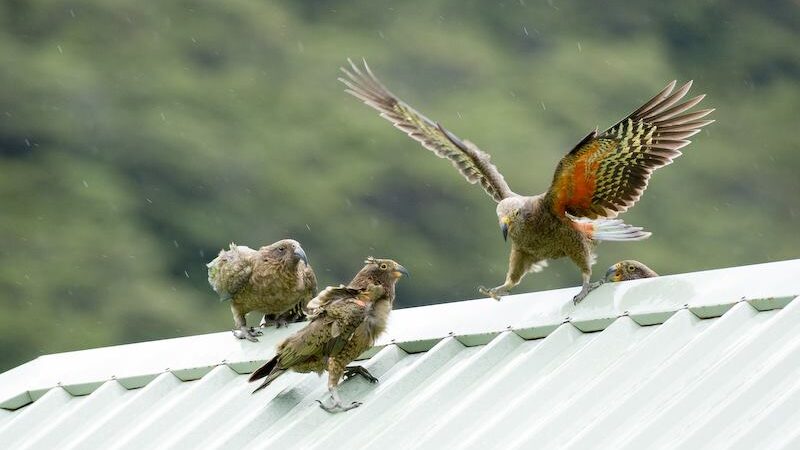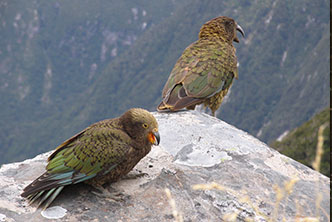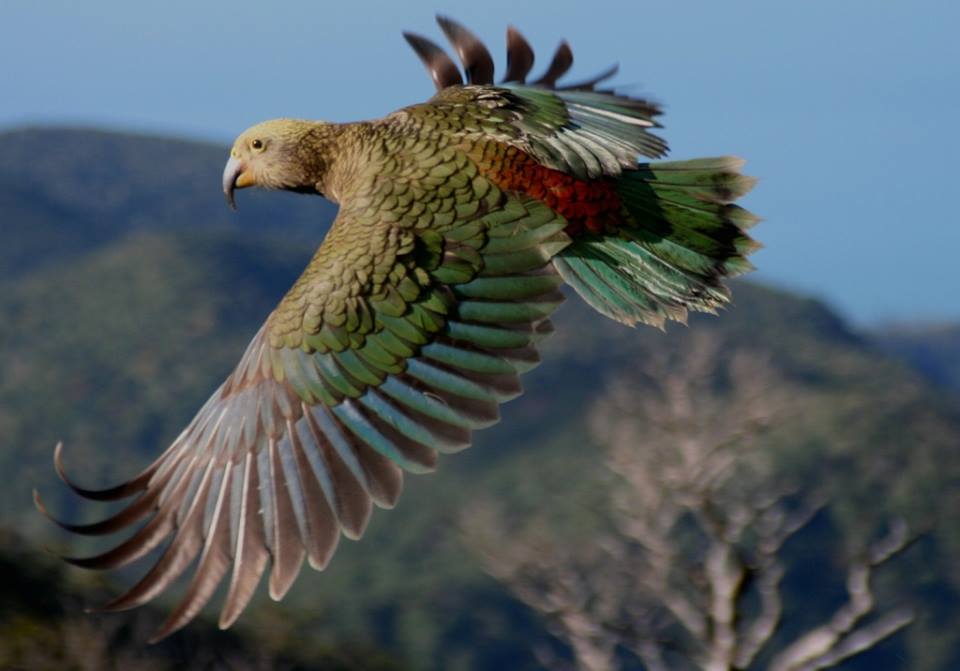Kea numbers are decreasing. Nesting adult females, their eggs and chicks are highly at risk from mammal predators. But are there other, invisible risks too?

Extinction risk isn’t simply a numbers game – it’s not just the population size of a species that indicates whether it’s at risk of becoming extinct. It’s also the genetic diversity within that population. A tiny remnant population with high genetic diversity may actually have better longterm prospects of recovery than a larger, but more homogenous population.
University of Otago zoologists, N. Dussex & B. C. Robertson investigated genetic diversity in kea populations in a paper just published in the New Zealand Journal of Zoology. First of all the researchers determined the effective population size (in genetic diversity terms) of the kea currently. They then used computer simulations to model what might happen to effective population size and genetic diversity in the future under several different management scenarios.
Why does genetic diversity matter?

Where there is little variation between individuals, there is less resilience in that population to events such as a new disease or parasite or the challenges of climate change for example. The risk that every remaining individual might fall victim to a new disease is greater if all the individuals are genetically very similar. Thus determining and maintaining genetic diversity within New Zealand’s many endangered species is becoming an increasing concern for conservationists. Conservation is no longer just about making the population bigger.
Interestingly, kea were already one of the rarest New Zealand birds at the time Europeans first arrived in Aotearoa.
“Recent genetic studies have shown that kea could have experienced population declines prior to European arrival, possibly in response to habitat change during the Holocene or because of the possible direct or indirect impacts of pre-European Māori. Subsequently, with the arrival of Europeans and the development of sheep farming, this scavenging, opportunistic species is suspected to have rapidly increased its population size and expanded its range.”
Initially kea dined well on high country mutton, but the good times weren’t to last.
“This expansion was followed by a quick decline over a period of 150 years, where an estimated 150,000 birds were killed under a governmental bounty scheme. The current population size is estimated between 1000–5000 individuals in the wild, but due to its often remote and rugged habitat, accurate estimates are difficult to obtain.”
So how do you determine genetic diversity risks – and what can you do about it?
The researchers use three different genetic methods to estimate the ‘contemporary population effective size’ (Ne) of the current kea population and from this figure, they infer what the actual ‘census size’ (NC) of the today’s kea population is likely to be. They then use simulations to predict what might happen to kea populations and genetic diversity in the future, with and without predator management.
“In this study, we also wanted to estimate the total population size NC of kea, because both Ne and NC play key roles in determining the degree to which populations can avoid extinction from demographically, environmentally or genetically stochastic events such as temporary recruitment failures, environmental catastrophes, inbreeding depression or a loss of genetic diversity at low population size. Understanding Ne/NC ratios may also reveal what ecological factors drive Ne below NC, insights which might facilitate more effective conservation and management decision-making.”
The forward simulations were designed to take into account various aspects of kea breeding behaviour.
‘Kea display lifelong monogamy, so our simulations did not include polygamy. Since kea pairs are territorial and reuse their nests year after year we specified that territorial breeders be prioritised for retention. In the case where one individual of a pair dies, the model assumes that a new mate will be found.”
One advantage of computer modelling is that it allows many possible simulations to be carried out.
“We ran 1000 replicates for each scenario over 10 generations (i.e. over 70 or 100 years depending on the generation time chosen). We also estimated the number of migrants required per generation to retain 90% of rare alleles over 10 generations and specifically tested the effect of variation of four demographic parameters: 1) initial number of adults; 2) initial sex ratio; 3) female survival; and 4) juvenile survival. We tested the effect of 3) and 4) in order to assess the effect of moderate and intense predator control.”
This approach was applied to hypothetical populations similar to the actual kea populations at Ōkārito and Arthur’s Pass.
“These are the best studied populations (i.e. candidate populations with most reliable estimate of number of pairs); ii) they represent both kinds of habitat of kea, the alpine one (Arthur’s Pass) where the species mostly occurs and the lowland one (Ōkārito), which seems to be a less typical habitat; and iii) these populations have been subject to moderate (Arthur’s Pass) and intense (Ōkārito) predator control. Using these two sample locations as surrogates of predator control intensity can give us an indication of the predator control required to retain 90% of rare alleles.”
Without immigration and with an effective starting population of 40, the probability of retaining a rare allele over 10 generations was found to be range from 53% to 67% in three different simulations.
“When testing for the effect of immigration, our simulations indicated that at least 15 immigrants per generation are required to retain a rare allele with 90% probability for simulation set I and 10 immigrants per generation for simulation sets II and III.”
Other population parameters were also tested to see what effect they had on the number of immigrants needed to maintain genetic diversity (90% probability of retaining a rare allele over 10 generations).
“The initial number of adults and adult female survival had little effect. Initial sex ratio (i.e. proportion of males) had a noticeable effect, especially when the proportion of females was < 0.5 and with an increased sex ratio of 0.9 requiring 14 to 25 immigrants per generation. Juvenile survival also had a large effect on the number of immigrants required per generation, with a survival rate < 0.3 requiring at least 25 to 30 immigrants in order to retain 90% of rare alleles. Finally, decreasing the age of senescence and increasing generation time did not affect the overall trends but always required a larger number of immigrants per generation to retain 90% of rare alleles.”

Because adult females are vulnerable to mammal predators when nesting, predation has the potential to skew the sex ratio in kea populations, so that there are more males than females. As the simulations show, this – along with the loss of juveniles to predators – puts genetic diversity at risk, with much more immigration into the population needed to compensate for that loss of diversity.
“The parameter that had the most influence on allele retention, when allowing for immigration, was juvenile survival. The chance of allele loss was especially strong when juvenile survival was smaller than 30%, a realistic value in monitored populations with no predator control. However, juvenile survival rate can reach up to 70% in the absence of stoat plagues. The ability of the species to maintain reasonable levels of genetic diversity with as little as 30% juvenile survival might explain why, despite a continued range-wide population decline, no evidence was found for a recent genetic bottleneck.”
So, for the moment it seems, the situation looks reasonably good for current kea genetic diversity. What then, are the conservation implications?
“Our forward simulations showed that artificial immigration is a valuable conservation approach for retaining allelic diversity in small and isolated kea populations. The amount of immigration was strongly dependent on juvenile survival and adult sex ratio. This means that for the Arthur’s Pass and Ōkārito populations, which represent moderate and intense predator control respectively, a few effective migrants per generation only could compensate for predation of females and chicks in order to retain rare neutral alleles. Translocations of females could also prove valuable in cases where the sex ratio of a focal population deviates from c. 0.5–0.6, in order to increase the probability of retaining rare alleles.”
So is translocation of kea a realistic conservation tool?
“Assisted migration has, however, never been implemented in kea in order to genetically supplement small populations. As previously recommended, translocation should be avoided across extremes of the range, but rather be done within each genetic cluster. For instance, birds that come into conflict with humans causing destruction to infrastructures, buildings and livestock, could be ideal candidates for translocations.”
What about the risks? Are there alternatives?
“Translocations can be financially and logistically challenging and could fail because there is a propensity for kea to frequently return to their home range. Therefore, other measures aimed at controlling key demographic parameters identified here, such as increasing carrying capacity and enhancing local juvenile recruitment via predator control, remain the preferred options to maximise maintenance of allelic diversity in kea. Predator control therefore needs to be maintained or newly implemented in other areas of the kea’s range, especially where potential management units have been identified.”
So more predator control for kea – rather than risky translocations looks to be the way to go.
This research is published in the New Zealand Journal of Zoology, where the abstract only is freely available. The full article is, however, freely available online through Researchgate:

